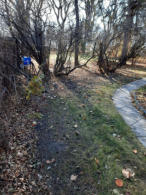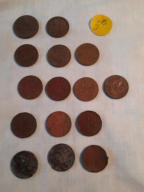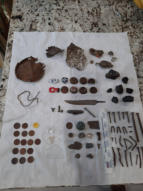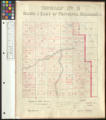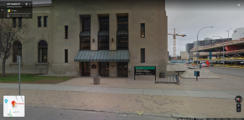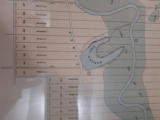

© 2025 Roger Fontaine, Designed by Bison Software

Metalman9
M
E
T
A
L
M
A
N
9


M
E
T
A
L
M
A
N
9


Ph: 204-223-7809
METALMAN9
Ph: 204-223-7809
METALMAN9
Click the date link, then a photo to start larger photo gallery & see descriptions

January 10, 2023 - Winter research project yields new Discoveries
January 10, 2023
Winter research project yields new Discoveries.
Let’s
first
go
back
to
basics
for
a
bit.
As
with
any
hobby,
a
little
research
can
go
a
long
way.
In-depth
research
goes
even
further.
Simple
internet
inquiries
like
“History
of
Manitoba”
or
“History
of
a
favorite
Town”
or
whatever
topic
interests
you
will
yield
all
kinds
of
leads
and
spur
ideas
as
to
where
you
might
like
to
go
Metal
Detecting.
For
example,
try
“Historical
Beaches
of
Manitoba”.
You’ll
get
some
historical
information
and
a
bonus
list
of
the
10
best
beaches
in
the
province.
Some
of
these
you
may
know
of,
others
may
be
totally
new
to
you.
Pick
a
topic
or
an
era
of
interest
and
peruse
it
on
the
internet.
Information
is
so
easy
to
access
today
and
then
go
exploring
with
your
detector
and
pin
pointer.
There
are
all
kinds
of
public
places
that
you
can
access
for
free.
And
your
research
is
now
done. It’s that easy!
For
those
that
like
a
little
more
of
a
challenge,
add
a
bunch
more
hours
on
line.
Delve
into
the
details.
Look
for
obscure
places
that
are
not
really
known
to
the
general
public.
Then
use
Google
Earth’s
Satellite
Imagery
to
get
a
close
up
look.
Your
local
library
is
also
a
great
place
to
start
your
research.
Another
great
source
of
information
are
the
local
residents
that
live
in
a
given
area
or
town.
Get
out
here
and
talk
to
people.
Try
using
this
thing
called
a
“Telephone”
and
call
up
a
local
municipal
office
and
ask
to
talk
to
someone
that
knows
about
the
local
history.
A
lot
can
be
learned
from
the
comfort
of
your
own
home
on
a
cold
winter
day
or
when
you’re
looking
for
a
new
place to get out too. Remember to keep it fun.
It’s
also
beneficial
to
know
what
you
like
to
detect.
For
example,
if
you
primarily
like
to
find
coins…
Coin
Shooter…
then
a
quick
google
search
of
your
city
will
show
you
each
and
every
bus
stop
in
town
and
it
will
show
you
every
public
park
too.
If
you
like
military
type
artifacts
then
find
out
where
the
old
WWI
or
WWII
training
bases
were.
Bridge
approaches
and
old
river
fords
can
yield
nice
treasures
too.
Many
of
the
detectorists
that
I
have
spoken
to
have
their
favorite
go
to
spots
and often, they have specific detecting interests. What’s yours?
Another
major
piece
of
research
is
getting
your
“Permission”.
You
must
have
permission
to
detect
on
private
land.
The
Metal
Detecting
Code
and
the
Law
demands
it.
This
will
undoubtedly
take
up
many
hours
of
research.
Canadian
privacy
laws
have
made
this
process
even
more
difficult.
Finding
who
owns
a
piece
of
land
and
their
phone
number
should
be
simple…
but
it’s
not.
Yet
it
needs
to
happen.
It’s
doable
but
it
can
take
a
lot
of
time
and
there
is
no
guarantee
that
you’ll
get
the
permission
that
you
are
hoping
for.
Call
me
“Old
School”
but
asking
someone,
in
person,
to
detect
on
their
property
tends
to
yield better results.
There
are
a
great
many
sources
for
information.
Too
many
to
list
here
but
I’ll
include
a
few
of
my
favorites
at
the
end
of
the
post.
Over
the
course
of
my
first
year
at
detecting,
I
spent
a
lot
of
time
watching
YouTube
videos.
I
still
do.
I
picked
up
a
lot
of
good
ideas
and
inspirations from it.
An
example
of
that
is
a
floating
screen
/
sand
filter.
I
built
one
using
pool
noodles,
a
½
inch
screen
and
a
wood
frame.
I’ve
also
learned
to
adapt
and
glean
information
from
various
government
websites
that
have
nothing
to
do
with
metal
detecting
but
by
putting
information
together
and
by
overlapping
maps,
I
can
better
focus
my
searches
when I go out.
Then there are the Manitoba Provincial Archives. The service is free.
In
December,
my
brother
and
I
attended
the
Archives.
I
had
booked
an
appointment
to
view
some
oversized
maps
that
had
been
printed
in
1870.
By
oversized,
we’re
talking
big:
3
feet
by
6
feet
or
so.
When
researching
at
a
deeper
level,
it
is
important
to
have
specifics
as
to
what
you’re
looking
for.
I
knew
the
legal
land
locations
of
what
I
wanted
to
look
at
and
I
have
my
permissions
in
place.
What
I
was
hoping
for
now
was
to
see
features
on
the
land
that
may
not
be
apparent
to
the
eye
today.
Also
of
particular
interest
to
my
brother
was
seeing
the
names
of
some
of
the
original
settlers.
We
discovered
farm
buildings
and
cultivated
areas
and
we
also
saw
multiple
cart
trails
that
served
as
the
original
Pembina
Trail.
Once
we
know
some
of
the
names
of
these
pioneers,
then
we
can
cross
reference
the
Census
from
that
time
period
and
discover
yet
more
fascinating
details of what life might have been like for these people.
We
also
arranged
to
see
our
great
great
grandfather’s
homestead
information
(1889)
and
documents
including
the
government
inspectors
notes
in
regards
to
the
160
acres
that
became
home
to
him,
his
wife,
and
5
children.
I
had
purchased
aerial
photographs
from
Natural
Resources
Canada
and
I
will
be
overlapping
these
photos
with
copies
of
the
maps
from
the
Archives
to
enhance
my
next
outing
and
hunt.
You
can
also
purchase
and
make
great
use
of
topographical
maps.
I
just
can’t
wait
for
spring
to
come
and
to
hit
the
ground
running.
Or
is
that
swinging?
Metal
detecting
and
history
are
indeed intertwined.
The
University
of
Manitoba
also
has
a
huge
amount
of
research
material and I assume that the University of Winnipeg does too.
And
last
but
not
least,
consider
joining
a
local
Metal
Detecting
Club
if
it
can
provide
benefits
that
fit
your
needs.
If
an
actual
club
is
not
for
you,
then
there
are
numerous
on-line
forums
you
might
want
to
consider.
The
long
and
short
of
it
is
that
you
can
Metal
Detect
at
whatever
level
you
like.
It’s
not
a
contest,
it’s
a
hobby.
It’s
a
hobby
that
tends
to
be
solitary
but
searching
with
a
friend
or
in
an
organized
group
can
be
a
lot
of
fun
too.
It’s
great
exercise,
it’s
the
great
outdoors
and
fresh
air,
and
it’s
meeting
new
people
and
learning
a
world
of
new
skills.
Get
out there and enjoy the day.
Roger
References:
http://canadianmetaldetecting.ca/canadian-metal-detecting-code-of-
ethics/
Goggle: Historical Beaches of Manitoba.
https://www.google.com/earth/index.html
https://www.gov.mb.ca/chc/archives/
https://www.bac-lac.gc.ca/eng/census/Pages/census.aspx
https://www.eodms-sgdot.nrcan-rncan.gc.ca/index-en.html
https://www.nrcan.gc.ca/earth-sciences/geography/topographic-
information/maps/9773
https://maps.google.com/maps/contrib/112056086582216082821
Picture by: Abulin Abulizi
https://mr4tunehunter.wordpress.com/

